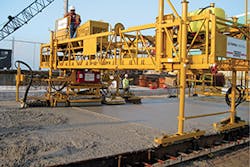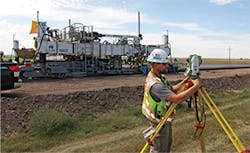Introduction
Prior to the actual placement of the concrete surface pavement, a long series of tasks and projects have to be completed first. These include: site hydrogeological investigations to determine local soil and groundwater characteristics, aerial and ground surveys of the proposed roadway alignments, the preparation of design plans and detail drawings, development of site specific specifications and construction standards, solicitation of bids and the awarding of the construction contract, mobilization of personnel and equipment to the site, delivery of materials and processing plants, clearing and grubbing of native vegetation, site grading to ensure positive drainage and provide for planned vertical and horizontal alignment, preparation and compaction of underlying soils, and placement of the pavement aggregate sub-layers and steel rebar reinforcement.
In addition to these many preparatory steps, the project itself has to meet multiple milestones. Once the contractor has received the construction materials and verified that they meet project specifications, he can then begin mobilizing his operators and equipment and begin laying down the roadway pavement. However, prior to construction of the pavement, buried utilities (storm and sanitary sewers, gas lines, power lines, etc.) are often trenched and installed first. Throughout the construction of the pavement, samples are taken and tested for strength characteristics and other material properties.
Once a section of roadway is completed and received surface concrete pavement, additional fixtures such as curbing, gutters, and manholes can be installed. And once completed, construction quality control procedures can be performed to certify that the installation has been performed to established design dimensions and performance specifications standards.
The following narrative will examine these steps along with the equipment required to complete these tasks. It’s a broad brush approach, but it gives an overall view of the full extent of work required for concert pavement construction.
But first we should examine what reinforced concrete is, its material characteristics, and how it differs from asphalt pavement.
Concrete vs. Asphalt Pavement
The primary functional difference between asphalt and concrete pavements is that the first is a flexible pavement, while the later is a rigid pavement. This is a result of the materials utilized in the construction of both types of pavement. The primary difference between the two is in how they respond to and support applied loads from vehicular traffic.
Flexible pavement is not reinforced by structural steel, polymer grid, or geosynthetic fabric. It transmits the applied vehicular loads from the surface down into tits subbase. The resultant deformation is spread through the layers of the pavements via contacts between the granular components of the pavement and into the underlying soils. The design of a flexible pavement is based on the load capacities of the various pavement layers and especially the soil. The load distribution resembles a triangle with the tip representing the maximum applied load and resultant deformation directly under the vehicular wheel. Flexible pavement therefore requires multiple structural layers: a surface wearing course of asphalt, a binder course, a base course of bituminous concrete, subbase course of larger aggregate, and a subgrade of compacted in place soil.
Rigid pavement is typically reinforced by structural steel rebar, dowel bars, or wire. Concrete is strong in compression, but relatively weak in tension. An applied load to a pavement slab induces compression loads in the top of the layer and tension loads in the bottom. Cracking from applied loads would first appear in the bottom half of a concrete slab, and work its way up through the slab until it completely fails. So it is in the bottom of the concrete layer that reinforcing steel (which is very strong in tension) is installed. At minimum, it usually receives enough shrinkage and temperature steel reinforcement to prevent cracking due temperature induced expansion and contraction.
As a rigid structure, reinforced concrete pavement acts more like a bridge, horizontally distributing vehicular loads instead of transmitting them directly downward into the underlying soils. It also consists of several layers: a surface course (or slab) of concrete and reinforcing steel, a subbase of large aggregate, and a subgrade of compacted in place soil.
Due to its rigid nature, concrete pavement is more susceptible to cracking and dislocation as a result of expansion and concentrations induced by temperature changes than is flexible asphalt pavement. For this reason, concrete pavement and slabs are often pours in segments separated by expansion/contraction joints. Strength is provided at these joints to eliminate vertical dislocation by the placement of short steel dowel rods at the midpoint of the slab thickness. These dowels are set at right angles to the joints and at regular intervals as determined by the design analysis.
Asphalt (also referred to as bituminous concrete) is an organic material product derived from petroleum via fractional distillation of crude oil. Its primary ingredients include polymers such as naphthene, hdyrocarbons, and asphaltenes.
IHC using a Guntert & Zimmerman Slipform Paver
A black, sticky, tar-like substance, asphalt is mixed with aggregate typically 5% asphalt/bitumen and 95% stone, sand, and gravel by weight), to form a fluid mixture that can be easily placed and spread over a roadway surface. Though fluid, asphalt is highly viscous and requires extensive heating to make it flow sufficiently to allow for application. After, placement is allowed to cure and hard, though this can happen relatively quickly allowing for vehicle traffic later the same day it is placed. Relatively inexpensive in its initial application, asphalt pavement can required extensive maintenance and repair to keep it structurally sound with a smooth surface that is safe to drive on.
The primary component of concrete is cement (the terms are often—and wrongly—used interchangeably). Used since Roman times, cement is a natural binding agent obtained by the burning and crushing soils and rock containing carbonate and carbonate of magnesia. Typically, cement consists of mixtures of lime, silica, alumina, calcium sulphate, fly ash, and other materials. These materials are referred to as pozzolans. The addition of water to cement first triggers a physical change where the dry cement powder becomes a slurry, and then a chemical change as the mixture dries and hardens. When exposed to moisture, the pozzolans within the cement chemically react with calcium hydroxide at ordinary temperatures to form hardened cement.
Concrete is a mixture of the binding cement described above, as well as aggregates, sand, crushed rock, recycled concrete chunks, and water. Though technically located within the mass of placed concrete, the steel reinforcement bars and wire are not considered to be part of the concrete mix. Depending on the mix, concrete can be made with differing curing times (28 days to complete hardening being the most common) and internal strength characteristics (with 3,000 psi being standard). The mixing ratios of concrete components are typically one part cement, three parts sand, and three parts aggregate, to produce a concrete with 3,000-psi strength. The cement as it dries not only hardens, it also binds the aggregate components of the concrete together to form a rigid solid mass. Though often initially more expensive than asphalt, concrete pavement has a much longer overall lifetime (more than 30 years, compared to 5 to 10 years for asphalt pavement). This longer lifetime combined with lower maintenance and repair costs results in a more financially efficient roadway design.
Concrete has other tangible advantages over asphalt. Minimizing maintenance requirements improves overall safety with less need for exposing repair crews, closing lanes, or limiting traffic flow. Concrete pavement is less likely to suffer pothole damage. It provides a higher friction surface with vehicle tires, thus reducing the potential for skidding and reducing the fuel costs of heavy vehicular traffic. It is less susceptible to damage from oil of fuel spills. When its useful lifetime is over, concrete pavement can removed and completely recycled as manmade aggregate for the next application of concrete mix. By not using oil as a material component, the use of concrete can save on the use of potentially expensive fossil fuels. Being light in color compared to black asphalt, concrete roads reflect the sun’s heat keeping the pavement and surrounding areas cooler and improving diver visibility.
IHC’s G&Z S1500 Paver
The Engineering and Design of Concrete Pavement
Every highway and road design begins in the mind of an engineer. From the engineer’s knowledge and experience come the construction details, plans and profiles, cross sections, alignments, details, specifications, and material quantities that define the proposed road construction plans. Construction details will define the installation, materials, and dimensions of the pavement, curbs, gutters, manholes and inlets, intersection layouts, underground utility installations, and paving transactions. Detail drawings also show joint spacing and types of joints between pavement sections. Types of details include traverse expansion and contraction joints to compensate for the effects of temperature induce strain on the pavement sections, longitudinal joints, construction joints, joints between roadways and driveways, and joints between pavement and other structures such as manhole risers. If “the devil is in the details”, so is the design. The dimensions of each detailed elements will determine the dimensions of the larger plan drawings that encompass the components.
Plans and profile drawings show the locations and alignments of the proposed roadways in plan views with matching profiles cut along the center off the roadway alignments. These profile drawings show the thickness of the pavement sections and the grades of the roadway centerline along with the relative locations of any intersecting buried utilities. Cross section drawings also show the pavement layer thicknesses and any intercepting utilities, but are set at right angles to the profile alignments and are shown at regular intervals along the length of the roadway profile. Cross sections are drawn (“cut”) at designated “stations” along the roadway length as measured along its centerline. Stationing is a standard method of numbering the length of the roadways at 100 feet intervals. (For example, STA 1+00 would be at the first 100 feet along the roadway centerline, while STA 5+27 would be at the 527 feet length.)
Specifications are the narrative description of the roadway design. Each state, county, and city department of transportation has its own set of standardized specifications and regulations that will set minimum standards for roadway construction. These specifications describe the minimum requirements for material types and strengths, installation procedures, standards of accuracy, and testing requirements. Accuracy is a reference to the surveying performed to ensure proper layout of the roadway and to check its finished line and grade to ensure that it has been properly installed. Testing requirements detail the sampling procedures and laboratory or field testing to be performed to ensure that the materials utilized for roadway construction meet strength standards and other required material characteristics.
These last two encompass the procedures associated with “construction quality control” (CQC). CQC involves all the actions that are performed to evaluate the construction effort and provide confidence that the proposed structure. CQC refers to all those specific procedures (including inspections, sampling and testing as well as certification surveying) that ensures that the construction adheres to the standards described in the plans and specifications.
“Construction quality assurance” (CQA), on the other hand, includes those construction and management procedures implemented to ensure proper construction methods and techniques are utilized. In short, CQC ensures that the construction standards specified by the CQA procedures have been met.
Specifications also deal with the management of the project. There is a division in each specification package that covers project and site management in addition to directly specifying the material standards for construction. The management specifications cover such issues as inspections, communications, records keeping, methods of measuring material quantities, basis of pavement, meetings, traffic control, stockpiling, erosion control structures, engineer’s status and chain of command, onsite health and safety, submittals formats, scheduling and scheduling revisions, chemical data, temporary facilities and utility hookups (construction trailers), housekeeping and waste management, system testing and demonstrations, and project closeout and site cleanup.
Material quantities are derived from the proposed plans and details. These drawings will give the lengths of the roadway alignments, the width of the operational lanes, and thicknesses of the various layers. Length times width times thickness gives the overall volume. Some materials, such as aggregate used in subbase construction, have their volumes converted to tons for purposes of shipping. With an allowance for field wastage and other material losses, the quantity of materials can be accurately ordered for the job. Ancillary quantities for related materials such as curbing and gutters, steel reinforcement, manholes, and buried utilities will also be derived from measures of the plans and detail drawings.
There are basically four different types of reinforced concrete pavement. Each uses a different method to transmit loads across joints between concrete pavement sections and slabs to prevent dislocation, cracking, and faulting. Concrete can either be formed into plain pavements or pavements that utilize steel rebar reinforcement. In plain pavements, load transfer at joints can be provided either by dowels or by the mechanism of underlying aggregate interlock. Concert pavement reinforced with steel rebar can also utilize dowels to transfer loads across contraction joints. Or, concrete pavements can dispense with contraction joints and rely on continuous longitudinal steel reinforcement.
Stringless paving with the G&Z S1500 Paver
The design and construction of concrete pavement varies with each application. Concrete pavement and slabs have found uses in airport runways, highways, roads, and parking lots. Airport runway pavement design is based on anticipate gear loads. (Which, in turn, is based on the assumption that 93 to 95% of the airplane’s weight is on the main landing gear.)
For example, the gear load from a Boeing 727 can range from 50,000 to 90,000 pounds. Given these loads, airport runway pavements can easily exceed a foot in thickness. For highways, design axle loads in many states can range from 18,000 to 20,000 pounds. In each case, the design analyses will factor in anticipated load and projected load repetitions, underlying soil strength, and other environmental factors to determine required pavement thickness and amount of steel reinforcement. (A detailed description of the design methodology and analyses procedures for each type of pavement is beyond the scope of this article).
Concrete Pavement Construction Procedures and Equipment Requirements
The concrete pavement construction effort consists of a series of sequential steps. After the subbase soil has been compacted and base course aggregate set in place, the most critical step is the timely delivery of sufficient quantities of concrete to the job site. This can either be done onsite with a mobile batch plant, or have the concrete delivered by cement mixer trucks loaded at a centrally located, permanent concrete facility. For large highway jobs that require significant quantities of concrete, a mobile batch plant located onsite may be preferred for reasons of cost and schedule.
Concrete can be made at two types of batching plants: either ready mix plants, or central mix plants. Ready mix plants combine all of the dry ingredients (aggregate, sand, cement) into a dry mix, which is poured into a ready mix truck with its signature rotating tank. The truck adds the water and mixes it with the dry ingredients while the truck is traveling to the job site. At central mix plants, all of the ingredients are mixed together, including the water with the final wet mix transported to the job site. This complete upfront mixing results in a more consistent, better quality product. Once the concrete mixing trucks arrive at the site, they can deposit their loads at the current workface. The components of the concrete plant can be shipped to the site and assembled separately, or be delivered as part of a single machine.
Prior to delivery of the concrete, the pavements subgrade and base have to be prepared. The subgrade is often compacted in place with a sheepsfoot roller to ensure necessary strength and density of the underlying soils. If required by weak soils, the underling subgrade can be stabilized by the addition of cement mixed into the soil. Once the subgrade is prepared, the base consisting of well graded aggregate (and often a sub-base layer consisting of larger aggregate) is installed. Bases layers and sub-bases can be constructed of free draining materials, cement treated, or otherwise stabilized. Once the base is installed to sufficient strength and thickness requirements the actual paving can commence.
The first step in paving is the placement of reinforcing steel, tie bars, wire, and dowels are placed at their required locations and heights relative to the final slab thickness. The diameter, grade, and location of the steel reinforcement is determined by project specific engineering analysis while meeting construction codes as defined by the Portland Cement Associating (PCA), state DOT standards, and local regulations.
With the steel in place, the pouring and paving of the concrete begins. There are two methods of placing concrete pavement: fixed forms and slip forms. The fixed form technique utilizes stationary metal framework and forms that define the edges of concrete placement. The forms are cleaned and greased prior to concrete pouring to ensure that the concrete does not stick to them when they are removed. Mechanical spreaders place and smooth the concrete to a level grade and smooth surface and shape, consolidate, and float finish the concrete.
The slipform machine travels along the roadway alignment on a set of tractor treads. As it moves, concrete is placed in front of the machine and subsequently consolidated, shaped to form its design edges, smoothed by screeds and float finished.
In both cases, the final surface is often textured with a wire broom to create a higher friction surface for driving safety. Once in place and surfaced, the concrete cures until it hardens. This can be done naturally, with waterproof polyethylene cover sheets (or old fashioned wet burlap), and/or with the assistance of additive curing compounds. Curing is complete when the concrete reaches its required strength.
The equipment required by concrete pavement construction is varied and specialized. This is especially true if the construction job involves the demolition and recycling of old concrete pavement. This effort can require jaw crushers, cone crushers, rock crushers and hammer mills, conveyor belts, and vibratory screeners. General hand tools and manual equipment can include air compressors, rock drills and jack hammers, rock splitters, jumping jack soil compactors and backfill tampers, circular saws, and simple hand brooms.
Earthmoving and grading performed prior to the roadway construction would require the use of dozers, front end loaders, excavators and backhoes, scraper/graders, and dump trucks. Prepping the graded ground surface can be performed with sheepsfoot rollers, tamping rollers, vibratory or static drum rollers, water spray trucks, soil tillers or pug mil mixers, and vibratory plate compactor attachments. Transporting and placing the concrete would be performed by mixer trucks, pavers, concrete vibrators, and portable curing machines.
Advances in Paving Technology: The Interstate 80 Project
Technological advances in paving methods continue to improve productivity and construction quality. An excellent example of this is the construction of a 40-feet-wide and 9.3-mile-long segment of I-80, utilizing a stringless paver and dowel bar inserter. The project was awarded by The Nebraska Department of Roads, and performed by Interstate Highway Construction Inc. (IHC), of Centennial, CO.
“The project included removal and reconstruction of both the eastbound and westbound lanes over the course of two years, spanning the 2015 and 2016 construction seasons,” says Cal Thomas, Vice President and Corporate Equipment Manager for IHC.
IHC finished the job ahead of schedule, earning it a production bonus while achieving a high-quality pavement finish, as measured by the International Roughness Index scale. To achieve this success, IHC utilized a Guntert & Zimmerman (G&Z) S1500 Slipform Paver, a Compact Dowel Bar Inserter (CDBI), along with stringless paving technology using the FAMC/Leica PaveSmart machine control system. The paver’s available NoLine Stringless Paving Preparation Kit was used to integrate this stringless paving capability to the S1500 Paver’s controls. This last piece of technology eliminates a string line for pavement placement since it automates the pavement’s cross slope and elevation grade. This system triangulates with four survey points and two survey transits signaling the receivers at the top of the paver.
Attaching the CDBI to the slip form paver saved time and eliminated the need for a concrete placer working with the paver operator. The paver configuration and an experienced crew allowed for the simultaneous installation of travel lanes (13 inches thick) and roadway shoulders (10 inches thick) along with a double crown as a monolithic pavement installation in a single pass.
“The machine telescopes 3.7 meters [12 feet] to either side of the 5.5-meter [18-foot] center frame module, allowing the S1500 to quickly adapt to paving widths from 5.5 to 12.8 meters [18 to 42 feet],” says John Eisenhour, National Accounts Manager for G&Z. “With optional bolt-in frame sections, the S1500 offers IHC total possible paving widths reaching 17.1 meters [56 feet].” The CDBI module was powered by the slip formers engine, and did not need its own power source, allowing for simultaneous insertion of up to 25 dowels at a time.
Using concrete from a batch plant located onsite reduced truck delivery times and transport costs. Mixed to Nebraska 47-B concrete standards at rates of 450 cubic yards an hour (455,000 cubic yards of concrete produced in total), construction rates averages 0.5 miles per day. The concrete was transported to the paver with end dump trucks, where it was placed in front of the advancing slip form paver. The stringless placement allowed for an extremely smooth and accurate finished grade.
Terex Bid-Well specializes in the development and manufacture of a line of specialized concrete paving machines for heavy construction and highway markets. The full line of automatic roller pavers includes bridge deck pavers and overlay machines; road, street, and airport pavers; texturing/curing machines; specialized paver/trimmer for slopes and canal paving; and workbridges.
The Terex Bid-Well 3600 paver utilizes two 21-horsepower Kohler ECH650 engines—one for the machine, and one to power the paving carriage—which reduce fuel consumption by up to 25% more than similar-size carbureted engines. It can pave widths 8–86 feet, while two standard 18-foot-wide end segments allow for up to 30 feet of variable width paving. A variety of options—including universal power crown adjuster, swing leg option, and pivot leg—make the 3600 paver one of the most flexible machines on the market.
The Terex Bid-Well 4800 paver excels at standard-duty flatwork paving, while the ability to pave both flatwork and bridge projects allows owner operators to maximize their return on investment. Its adaptable truss frame design allows for paving of a variety of light-duty flatwork applications such as port decks, urban development roads, highways, sewage tank bottoms, warehouse floors, and parking lots. Additionally, the automatic roller paver’s flexible frame makes it possible to pave complex slabs that flare, or require variable or inverted crowns. Machine crown points can be manually set at any hinge on the frame, enabling the contractor to establish single or multiple crowns in the slab from +6%, to -1.9%.
The 4800 paver’s frame rides the rail on four heavy-duty, 6-inch diameter legs and eight bogie screed rollers, offering an 11.5-foot total span. Its 48-inch truss frame depth allows for standard machine lengths 36–120 feet for paving widths of 12–116 feet. A separate 23-hp gas engine powers the machine’s paving carriage, which rides along the truss frame via a heavy-duty dual chain drive.
Advanced “spud” vibrators, positioned in front of the paving carriage for flatwork paving, impart vibration forces to the outer edges of the pavement. The Terex Bid-Well patented Rota-Vibe consolidates the top 2.75 inches of concrete, delivering a denser, and more uniformly consolidated, surface. Profitability is further increased by this machine’s low cost, compared to standard slipform pavers.
The concrete industry has full-service concrete contractors such as CASE Construction, as well as equipment suppliers. They provide concrete pavement construction services for building foundations, floor slabs, approach ramps, sidewalks, curbs, parking lots truck offloading bays, roads and highways, and associated drainage structures. Their expertise and experience is expressed through a turnkey approach and project flexibility. In addition to concrete pavement, CASE constructs specialized concrete structures, including foundations for specialized manufacturing equipment, power turbine and machinery foundations, concrete-lined sumps and trenches, barrier and retaining walls, concrete-lined retention ponds and stormwater diversion channels, renovations, and, even, decorative concrete surfaces.







